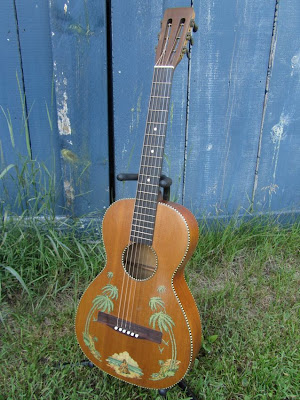c.1930 Harmony Hawaiian-decal "Parlor" Guitar
This one's unmarked, but this slightly-smaller than "0" size guitar, with its 12th fret join, was certainly made by Harmony in Chicago around 1925-1930. It's got a spruce top, slightly curled birch back and sides (with fun grain), and a poplar v-neck. The 24 1/4" scale is very typical for Harmony and seems short for our time but was pretty usual back when this was made.
I posted this guitar last year when it had a bolted-on metal bridge (a period type) but just recently it was traded back to me in part for another instrument. I decided to dispatch with the bolted-on bridge, installed a new rosewood one, and gave it a good setup afterwards. I also installed a through-heel neck bolt at the same time to sturdy-up the neck joint.
Previous repairs included some hairline crack repair to the top and the back, a neck reset, fret level and dress, cleaning, and setup.
The quality of the spruce on the top is great -- has that nice sort of silking stuff going on to the cross of the grain. The guitar itself is also feather-light and and coupled with the thin, lightly ladder-braced top, gives this wonderful sustain, volume, and tone. It's a perfect instrument for fingerpicking or light to medium-strength backing strumming. Of all the old Harmony "parlors" in similar models to this one (same design, different appointments) that I've worked on (and that's a lot of them), this is probably my first pick for sound. It's lush and full and competes well with bigger, more modern instruments.
I added the bone nut last year to replace a damaged original.
Fret markers are inlaid celluloid dots. The frets themselves are original brass and are standard-issue for the time --thin, smallish, and low-ish.
Here's my replacement rosewood bridge. I cut it down from a stash of old-stock bridges I have in my parts bin. I decided to install individually-adjustable tiny screws as this guitar's "saddle." Because this guitar was originally a Hawaiian model (with a raised nut and high action for lap/slide playing) and one can tell that by the (originally) absent strap button, I thought it would be cool to be able to adjust the action up "on the fly" to make it into a slide player if desired. It also makes micro-adjustments to action much easier from year to year.
Currently the action is "spot on" at 3/32" at the 12th fret. This guitar really needs extra-light or lighter strings to keep its top safe. Anything heavier and the lightly-braced top will start to belly more over time.
The checker binding is wonderful and all there, as is the two-ply purfling attached to it. See the light pickwear near the soundhole?
The top is a lovely medium-golden color with its aged-in finish. Also check out how beautifully the "Hawaiian scene" decals are preserved, too!
Do you see how the light is catching some "wrinkles" on the back? The back has these swellings on its upper and lower parts -- the wood is warped -- but curiously enough there's no deformation at the edges and only a small hairline crack (repaired) at the upper bout rear. This must have happened due to loss of moisture and some heat over time, but the guitar itself doesn't show any real signs of heat damage, so I have a feeling the wood wasn't particularly dried-out correctly when it was made.
Fortunately, it's all intact and the bracing is intact and glued-in too, except for where the bulging wood has warped away from under the braces here and there.
Tuners are original bakelite-buttoned 3-on-a-plate types and they work great.
See the strap button? It's on top of a shaped mount that conforms to the heel nicely and then the bolt travels through to the interior of the neck-block where it's tightened up with a wingnut. I installed this to reinforce the neck set since the dovetail inside was not the most artistic work done by Harmony. As expected, this works great.
The birch on the back has some cool "depth" to it in the way of light curly figure throughout. Combined with the "natural cherry" colored finish, it looks awfully pretty on this guitar.
A looker!
The sides are all crack free. Also check out the nice semi-gloss finish -- still shining though it of course shows a bit of wear overall. The side wood has nice graining to it -- at a glance it almost looks like cherry, but it's birch.
To match the one at the neck, I installed a strap button at the endblock area as well. This guitar was intended to be a Hawaiian "lap" model to begin with, so it never had a strap button from the factory.
Decal closeup. Pretty cool!
When I reset the neck I had to remove the fretboard extension and sand down the bottom to make it more of a wedge shape to fit correctly, but the 12th fret was stubborn and chipped the board before I even barely pulled it up. I've since back-filled it with the board's own sanding dust and leveled it off, but it's obvious on close inspection that it's been filled in.
Also note the hairline cracks in the fretboard itself. These are pretty usual on dried-up old dyed-wood fretboards like this one, but I drop-filled them with glue previously to help stabilize them.





















Comments
That is a very creative idea to use screws for the string saddles. Did you need to install metal inserts in the bridge first or were you able to put the screws directly into the wood?
Ben
Did I also mention it gives a great sound? More direct, less color from the saddle itself.